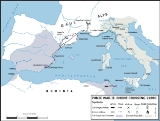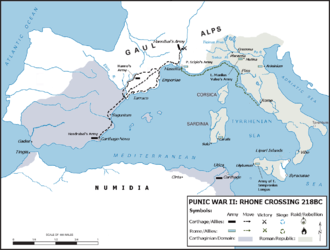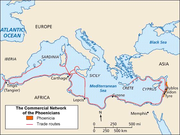
Carthaginian Iberia
Encyclopedia

History of Carthage
The study of the history of Carthage is often problematic. Due to the subjugation of the civilization by the Romans at the end of the Third Punic War, very few Carthaginian historical primary sources survive. There are a few ancient translations of Punic texts into Greek and Latin, as well as...
presence in Iberia
Iberian Peninsula
The Iberian Peninsula , sometimes called Iberia, is located in the extreme southwest of Europe and includes the modern-day sovereign states of Spain, Portugal and Andorra, as well as the British Overseas Territory of Gibraltar...
lasted from 575 BC to 206 BC when the Carthaginians were defeated at the Battle of Ilipa
Battle of Ilipa
The Battle of Ilipa in 206 BC was considered Scipio Africanus’s most brilliant victory in his military career during the Second Punic War. Though it may not seem to be as original as Hannibal’s tactic at Cannae, Scipio’s pre-battle maneuver and his Reverse Cannae formation was still a culmination...
in the Second Punic War
Second Punic War
The Second Punic War, also referred to as The Hannibalic War and The War Against Hannibal, lasted from 218 to 201 BC and involved combatants in the western and eastern Mediterranean. This was the second major war between Carthage and the Roman Republic, with the participation of the Berbers on...
.
Background

Phoenicia
Phoenicia , was an ancient civilization in Canaan which covered most of the western, coastal part of the Fertile Crescent. Several major Phoenician cities were built on the coastline of the Mediterranean. It was an enterprising maritime trading culture that spread across the Mediterranean from 1550...
ns were a people from the eastern Mediterranean who were mainly traders from the cities of Tyre, Sidon
Sidon
Sidon or Saïda is the third-largest city in Lebanon. It is located in the South Governorate of Lebanon, on the Mediterranean coast, about 40 km north of Tyre and 40 km south of the capital Beirut. In Genesis, Sidon is the son of Canaan the grandson of Noah...
, and Byblos
Byblos
Byblos is the Greek name of the Phoenician city Gebal . It is a Mediterranean city in the Mount Lebanon Governorate of present-day Lebanon under the current Arabic name of Jubayl and was also referred to as Gibelet during the Crusades...
. They colonised much of the Mediterranean and in the year 814 BC, they founded the city of Carthage
Carthage
Carthage , implying it was a 'new Tyre') is a major urban centre that has existed for nearly 3,000 years on the Gulf of Tunis, developing from a Phoenician colony of the 1st millennium BC...
. After the fall of Phoenicia
Phoenicia
Phoenicia , was an ancient civilization in Canaan which covered most of the western, coastal part of the Fertile Crescent. Several major Phoenician cities were built on the coastline of the Mediterranean. It was an enterprising maritime trading culture that spread across the Mediterranean from 1550...
to the Babylon
Babylon
Babylon was an Akkadian city-state of ancient Mesopotamia, the remains of which are found in present-day Al Hillah, Babil Province, Iraq, about 85 kilometers south of Baghdad...
ians and Persians, Carthage became the most powerful Phoenician colony in the Mediterranean and the Carthaginians annexed many of the other Phoenician colonies around the coast of the western Mediterranean, such as Hadrumetum
Hadrumetum
Hadrumetum was a Phoenician colony that pre-dated Carthage and stood on the site of modern-day Sousse, Tunisia.-Ancient history:...
and Thapsus
Thapsus
Thapsus was an ancient city in what is modern day Tunisia. Its ruins exist at Ras Dimas near Bekalta, approximately 200 km southeast of Carthage. Originally founded by Phoenicians, it served as a marketplace on the coast of the province Byzacena in Africa Propria...
. They also annexed territory in Sicily
Sicily
Sicily is a region of Italy, and is the largest island in the Mediterranean Sea. Along with the surrounding minor islands, it constitutes an autonomous region of Italy, the Regione Autonoma Siciliana Sicily has a rich and unique culture, especially with regard to the arts, music, literature,...
, Africa
Africa
Africa is the world's second largest and second most populous continent, after Asia. At about 30.2 million km² including adjacent islands, it covers 6% of the Earth's total surface area and 20.4% of the total land area...
, Sardinia
Sardinia
Sardinia is the second-largest island in the Mediterranean Sea . It is an autonomous region of Italy, and the nearest land masses are the French island of Corsica, the Italian Peninsula, Sicily, Tunisia and the Spanish Balearic Islands.The name Sardinia is from the pre-Roman noun *sard[],...
and in 575 BC, they created colonies on the Iberian peninsula.
Expansion into Iberia
After the defeat of Carthage in the First Punic WarFirst Punic War
The First Punic War was the first of three wars fought between Ancient Carthage and the Roman Republic. For 23 years, the two powers struggled for supremacy in the western Mediterranean Sea, primarily on the Mediterranean island of Sicily and its surrounding waters but also to a lesser extent in...
, the Carthaginian general Hamilcar Barca
Hamilcar Barca
Hamilcar Barca or Barcas was a Carthaginian general and statesman, leader of the Barcid family, and father of Hannibal, Hasdrubal and Mago. He was also father-in-law to Hasdrubal the Fair....
successfully crushed a mercenary revolt in Africa and trained a new army consisting of Numidians
Numidians
The Numidians were Berber tribes who lived in Numidia, in Algeria east of Constantine and in part of Tunisia. The Numidians were one of the earliest natives to trade with the settlers of Carthage. As Carthage grew, the relationship with the Numidians blossomed. Carthage's military used the Numidian...
along with mercenaries and other infantry and in 236 BC, he led an expedition to Iberia where he hoped to gain a new empire for Carthage to compensate for the territories that had been lost in the recent conflicts with Rome
Roman Republic
The Roman Republic was the period of the ancient Roman civilization where the government operated as a republic. It began with the overthrow of the Roman monarchy, traditionally dated around 508 BC, and its replacement by a government headed by two consuls, elected annually by the citizens and...
and to serve as a base for vengeance against the Romans.
In eight years, by force of arms and diplomacy, he secured an extensive territory in Hispania
Hispania
Another theory holds that the name derives from Ezpanna, the Basque word for "border" or "edge", thus meaning the farthest area or place. Isidore of Sevilla considered Hispania derived from Hispalis....
, but his premature death in battle (228 BC) prevented him from completing the conquest.
Fall of the Empire
The fall of Carthage's Iberian territories came in the Second Punic War.In the year 209, after the romans had landed on Iberia under the command
of Scipio Africanus
Scipio Africanus
Publius Cornelius Scipio Africanus , also known as Scipio Africanus and Scipio the Elder, was a general in the Second Punic War and statesman of the Roman Republic...
, they captured the centre of Punic power in Iberia, Cartagena
Then they moved south and faced the punic army of Hasdrubal in the Battle of Baecula
Battle of Baecula
The Battle of Baecula was Scipio Africanus’s first major field battle after he had taken command of Roman interests in Iberia during the Second Punic War, in which he routed the Carthaginian army under the command of Hasdrubal Barca.-Prelude:...
but was not able to prevent him
from continuing his march to Italy in order to reinforce his brother Hannibal.This catastrophic defeat sealed the fate of the Carthaginian presence in Iberia. It was followed by the Roman capture of Gades in 206 BC after the city had already rebelled against Carthaginian rule. A last attempt was made by Mago in 205 BC to recapture New Carthage while the Roman presence was shaken by a mutiny and an Iberian uprising against their new overlords. But the attack was repulsed. So in the same year he left Iberia, setting sail from the Balearic islands to Italy with his remaining forces.
Art and artefacts of Phoenician influence in Celt-Iberia
Four Celto-Iberian "Ladies": Lady of Cerro de los SantosDama del Cerro de los Santos
Dama del Cerro de los Santos, also known as Gran Dama Oferente, is an Iberian sculpture from the 2nd century BC, that is now in National Archaeological Museum of Spain in Madrid....
, Lady of Baza
Lady of Baza
The Lady of Baza is a famous example of Iberian sculpture by the Bastetani. It is a limestone female figure with traces of painted detail in a stuccoed surface that was found on July 22, 1971 by Francisco José Presedo Velo, at Baza, in the altiplano, the high tableland in the northwest of the...
, Lady of Guardamar
Lady of Guardamar
Lady of Guardamar , also known as the Lady of Cabezo Lucero, is a limestone female bust, 50 cm high, dated circa 400 BC, that was discovered in fragments in the Phoenecian archaeological site of Cabezo Lucero in Guardamar del Segura in Alicante province, Spain, on September 22, 1987.A large piece...
, and Lady of Elche, are dated around 4th century BCE.
The Lady of Guardamar, found in 1987, is in the Museum of Alicante. When the Lady of Elche was found, it was thought to be of Hellenic influence, but since the discovery of the Guardamar Lady in 1987, in the Phoenician
Phoenician
Phoenician may refer to:*Phoenicia, the ancient civilization*Phoenician alphabet*Phoenician languagePhoenician may also be:*A native or resident of Phoenix, Arizona-See also:*Phoenix *Phoenicia...
(Carthaginian) site of Guardamar near Alicante
Alicante
Alicante or Alacant is a city in Spain, the capital of the province of Alicante and of the comarca of Alacantí, in the south of the Valencian Community. It is also a historic Mediterranean port. The population of the city of Alicante proper was 334,418, estimated , ranking as the second-largest...
(Lucentum
Lucentum
Lucentum is the name of the Roman predecessor of the city of Alicante, Spain. Particularly, it refers to the archaeological site in which the remains of this ancient settlement lie, at a place known as El Tossal de Manises, in the neighborhood of Albufereta.-Ancient History:Before the arrival of...
), Phoenician would seem to be the appropriate designation.
This series of sculptures can be seen as types of funerary urns to hold ashes. There has been speculation that the Elche bust was originally full-length. Mythological animals of an earlier period – 6th-5th century BC: the Bull of Osuna
Bull of Osuna
The Bull of Osuna is a limestone high relief Iberian sculpture, 82 cm high, dated from the end of the 5th century BC, that is on display at the National Archaeological Museum of Spain in Madrid....
, the Sphinx of Agost
Sphinx of Agost
The Sphinx of Agost is a Greek-influenced Iberian limestone sculpture, dated from the late sixth century BC, that was found in the Agost reservoir in Alicante, Spain, in 1893....
and the Biche of Balazote
Biche of Balazote
The so-called Bicha of Balazote is an Iberian sculpture that was found in the borough of Balazote in Albacete province , Spain. It was first studied by a group of French archaeologists who identified it as a kind of deer, hence the name 'biche' , which was then Castillianized to 'bicha', i.e.,...
, are in the Archaeological Museum of Madrid.
See also
- Timeline of Portuguese historyTimeline of Portuguese historyThis is a historical timeline of Portugal.*Timeline of Iberian prehistory*Pre-Roman Iberia *Roman Lusitania and Gallaecia *Germanic Kingdoms...
- Timeline of Iberian prehistory
- Timeline of pre-Roman Iberian history (before the 3rd century BC)Timeline of pre-Roman Iberian historyThis section of the timeline of Iberian history concerns events from before the Carthaginian conquests .-Bronze Age:*2nd millennium BC** c. 1800 BC – The El Argar civilization appears in Almería, south-east of Spain, replacing the earlier civilization of Los Millares. The adoption of bronze...
- Timeline of Portuguese history - Roman Lusitania and Gallaecia (3rd century BC to 4th century AD)Timeline of Portuguese history (Lusitania and Gallaecia)This is a historical timeline of Portugal.-3rd century BC:*237 BC - The Carthaginian General Hamilcar Barca enters Iberia with his armies through Gadir.*228 BC - Hamilcar Barca dies in battle...

